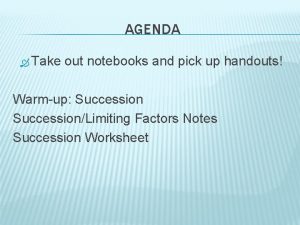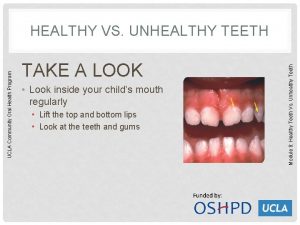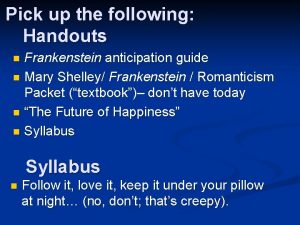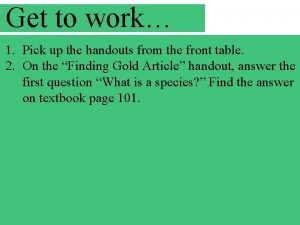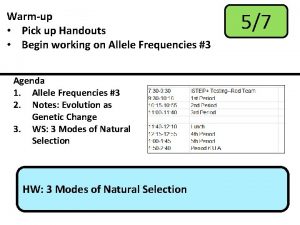Pick up your handouts Take a look at

































- Slides: 33

Pick up your handouts. Take a look at the updated syllabus.

Social Graces Answer each question as best you can. Don’t consult others– this is YOUR opinion!

Jane Austen See handout.

How Austen’s Style Exploits Her Material

The First Sentence “It is a truth universally acknowledged, that a single man in possession of a good fortune must be in want of a wife. ” This modest-looking statement sums up the chief conflict in the novel: 1. A convention of love – Man pursues woman 2. Savage economic reality – Insolvent women must run down male “property. ”

Here we see the ironic mode of opposition and union: 1. Civilized convention 2. Economic primitivism These unite in the sentence just as they do in the action, where 1. feelings and 2. fortune, initially in conflict, are reconciled in the union of marriage.

Pride and Prejudice (2005)

Take a vote!! Watch The Importance of being Earnest Listen to a dramatic reading of Pride and Prejudice. (We will get through a few chapters. )

Pride and Prejudice Propriety Notes


Propriety Conformity to what is socially acceptable in conduct or speech Fear of offending against conventional rules of behavior especially between the sexes Customs and manners of polite society

The definition of true propriety that Pride and Prejudice offers is simply a healthy respect for the conventional rules of social behavior, modified by an understanding that those forms are important, not as ends in themselves, but as means of regulating social intercourse, and that therefore they need not always be followed slavishly.

Austen Divides Propriety into Two Classes 1. Rules that represent the social codification of basic moral principles Example: Breaking a first engagement because one has received a more appealing second 2. Rules that are primarily matters of fashion or convenience Example: Young ladies taking long country walks by themselves

Lack of Propriety Mr. Collins has fallen in love with two of the commonest forms of politeness, the apology and the thank you, and has completely failed to understand that these forms have definite functions in social intercourse Sir William Lucas has moved to where “he could think with pleasure of his own importance, and unshackled by business, occupy himself solely in being civil to all the world. ” The purpose of civility has been forgotten

Choose a side. Defend it. Can we make the basic assumption that a person’s outward manners mirror his or her moral character? Original title of Pride and Prejudice was First Impressions Remember that classic literature frequently equated physical ugliness with moral ugliness yes no

After the quiz fill in the following chart: Character Family name Home and its location Characterized as… Social status and attitude towards it Elizabeth Bennet Longbourn, near Meryton, Hartfordshire Witty, bold, beautiful Middle class, content (list as many as you find) Mrs. Bennet etc. Reminders: Vocab Test (7 -9)

Women in Austen’s Time (The Ones We Do Not See)

England 200 Years Ago Because people were so poor – most people – they would run, toil, and sweat all day and night to save themselves and their children from starvation. Kind of like India is today.

If you are a child and your parents die, you live on the streets If you are a young woman and give birth out of wedlock, you would be judged a “moral imbecile” and sent to a lunatic asylum If you tried to commit suicide to escape such a life, you would be saved, and then hanged If you stole anything over five pounds you would be hanged – The age of criminal liability was seven

If you were a maid, you could expect to work eighteen hour days, six and a half days a week, with one day off a month, and consider yourself lucky. Your duties included - but were not limited to - cooking, cleaning, washing clothes, carrying water etc.

If you were not a maid, you were probably working the land: chopping wood, feeding the animals, milking the cows, planting, gathering hay Your reward for performing your duties - as stated in the Bible - is to go to heaven The rich therefore had a moral obligation to keep the poor in their place

Or You could become a prostitute Estimates reckon 70, 000 out of the 475, 000 women in London in 1801 “chose” this option

Only 30% of women married The sense of sexual sin ran high: the fear of pregnancy was great – estimates claim around half the nation’s women remained virgins their whole life

The average of puberty in 1801 was 15 for girls and 17 for boys. In the 1960 s, records show girls hitting puberty at 11, boys at 14. Present day statistics are 9 years 10 months for girls, 11 -12 for boys. Studies show that the age for puberty is continuing to drop (npr. org). Marriage typically occurred between the ages of 25 to 28 The median age for marriage in the 1950 s was 23 for men and 20 for women. In 2004, it rose to 27 for men and 26 for women. Jane Austen put on her cap when she was 30. That is, she announced by her mode of dress as being out of the marriage market

Between 1650 and 1850 there were 250 divorces The fact that there was such rampant prostitution suggests that your husband was probably not virginal on your marriage night Chances were high he was diseased Good news: NPR reports that divorce rates are actually dropping. The feminist movement affected divorce rates (evil bra-burners), but people are marrying later in life now, which has allowed more mature and lasting marriages. Woo hoo! (“The Truth About The Divorce Rate Is Surprisingly Optimistic” npr. org)








Pride and Prejudice Discussion In groups of 4 -6, you will examine three subjects: significant moments, critical approaches, and symbolism of locations. You will write your findings on a piece of construction paper and share your responses with the class. The work from all classes will be scanned and posted online. Identify at least two significant moments in the text. It can be connected to characterization, plot, theme, etc. For each moment, identify the page(s), devices employed, and connection to theme. Choose one critical approach (first come first serve): biographical, psychological, historical/neo-historical, Marxist, gender, deconstructionist. For your approach, look up the definition and apply it to the text. Identify at least two symbolic locations (almost all are symbolic). Find the page where the location is described and write what the location symbolizes.
 Look up look down look left look right
Look up look down look left look right Zoo103 handouts pdf
Zoo103 handouts pdf Jane schaffer format example
Jane schaffer format example Sample of handouts
Sample of handouts Handouts gestalten
Handouts gestalten Cs408 handouts
Cs408 handouts Cs408 handouts
Cs408 handouts Define handouts
Define handouts Studenthandouts.com
Studenthandouts.com Www.studenthandouts.com
Www.studenthandouts.com Gapped handouts
Gapped handouts Advantages and disadvantages of handouts
Advantages and disadvantages of handouts Patient education handout template
Patient education handout template Advantages and disadvantages of handouts
Advantages and disadvantages of handouts Student handouts inc
Student handouts inc Take a bus or take a train
Take a bus or take a train Name the following pictures
Name the following pictures Look at the pictures
Look at the pictures Picture analysis activity 1
Picture analysis activity 1 Look at the following image and write predictions
Look at the following image and write predictions Look the pictures and answer the questions
Look the pictures and answer the questions Activity 1 a look at the picture
Activity 1 a look at the picture Look at activity 1 and answer
Look at activity 1 and answer Give us your hungry your tired your poor
Give us your hungry your tired your poor Take out your notebook
Take out your notebook Take out your homework
Take out your homework Take away any liquid near your working area true or false
Take away any liquid near your working area true or false Take out your notebooks
Take out your notebooks Don't let anyone take your crown
Don't let anyone take your crown How to take care of your nervous system
How to take care of your nervous system How to take care of your skeletal system
How to take care of your skeletal system Vicente y francisco / jugar / al vóleibol los domingos
Vicente y francisco / jugar / al vóleibol los domingos Take 100 responsibility for your life
Take 100 responsibility for your life Friction
Friction



































